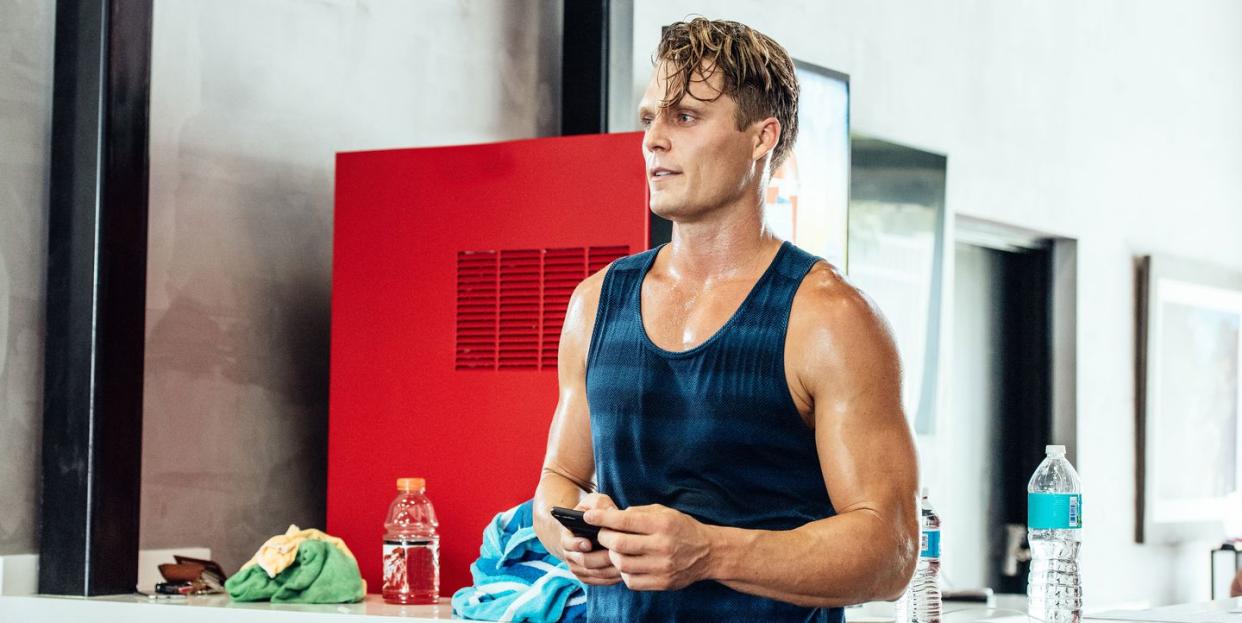9 Tips to Protect Your Skin After a Sweaty Workout

No one is going to argue that working out is bad for you. Especially not here at Men’s Health. However, there are a lot of things lurking around the gym that can do more harm than good. And those things can wreak havoc on your skin.
We’re talking mainly about bacteria and fungus, and they’re everywhere. Both of these things thrive in moist environments and because you and everyone else around you is sweating their asses off in the gym, it’s a truly wild environment for both bacteria and fungus to run rampant. Not just on the equipment either, on your body too, which can lead to a variety of skin issues.
Number one among them: acne. According to dermatologist Adam Geyer, MD, acne is caused by bacteria called Propionibacterium acnes (or P-Acnes) that thrives in a moist, sweaty environment. “The more we work out, the more we perspire, which makes us a better Petri dish,” he says. “People who work out a lot can often find an increase in pimples on their chest, back, and face.” Exercise also can increase testosterone levels, which in term tell your oil glands to produce more oil, making you even more moist and helping even more P-acnes grow. “It’s a feedback loop,” he says.
Complicating the issue, not all body pimples are actually acne. They could also be folliculitis, which is an inflammation of the hair follicles. Folliculitis looks like acne and is also caused by bacteria, but a different kind that likes to burrow down into your hair follicles and block them. Sweat helps them along. Chances are, if you notice pimples on your legs, arms, or torso, it’s probably folliculitis instead of acne. Apart from not looking great, folliculitis can be linked to staph and other types of infections. Dr. Geyer recommends using benzoyl peroxide on both acne and folliculitis to help dry out the pores and kill the bacteria (either in a spot treatment or cleanser).
Here are the other ways to protect your skin from the gym and make sure it stays looking its best. After all, you’re putting in all the work, you don’t want a breakout to ruin it all.
Always Shower After Your Sweaty Workout
Perhaps most obviously, the best thing you can do for your skin is to shower after your workout. “It helps to remove the build up of sweat and oils that you're secreting during your workout,” says Dr. Geyer. It also helps get rid of any other microbes and bacteria you may have been exposed to from touching surfaces all over the gym. Showering isn’t just about looking good either, it actually does make you smell better too. “It's not our sweat that smells, it's the bacteria that grows in it that causes odor,” he says. Bring your own body and face cleanser to the gym instead of relying on ones they provide, since they’re often not antimicrobial. It’s especially important if you’re prone to acne, since you should use one that contains acne-fighting ingredients like salicylic acid or benzoyl peroxide.
Use Body Wipes If You Can't Shower
Realistically, we can’t always spend the time to take a full shower after every workout. In those cases, you still need to clean off the sweat before you leave. Leaving sweat to dry on your body can keep the bacteria inside your pores, which makes breakouts and folliculitis more likely. Use a cleansing wipe to quickly clean off sweaty areas like your chest and arm pits. They often contain skin-friendly ingredients to help cleanse and protect skin. Just remember, these aren’t a substitute for a shower, they’ll just help tide you over till you get home.

Hot Showers Are Not Always the Best Idea
Showering with hot water feels great, especially in winter, but it can actually dry your skin out too much in the long run according to Dr. Geyer. Dry skin can be itchy and if you scratch your skin too much, it can make it easier for bacteria and yeast to get in. This is especially bad in high-risk environments like the gym. “A compromised skin barrier can make you more vulnerable to rashes, irritation, and infection,” says Dr. Geyer. Instead shower in warm or lukewarm water, especially if you are prone to dry skin.
Use the Right Skincare Products
The skincare products you’re using every day should have two functions: to help cleanse, but not overly dry your skin, and to help protect your skin’s barrier. The products you use at they gym are no different. Dr. Geyer recommends always using products specifically designed for your skin type to get the most benefits. He says to use a gel cleanser if you’re prone to acne or a cream cleanser if you have sensitive skin. Follow it with an oil-free moisturizer if you have oily skin or a rich cream if you have dry skin.
Always Wash Your Clothes and Towels
We’ve established that bacteria lives for sweat and that sweat isn’t just found on your skin. If you’re not washing and rotating your gym clothes enough, you could be undermining all those showers. “Re-wearing gym clothes is a source of exposure to bacteria that may live in sweatier clothes, and making sure to have fresh workout attire can be helpful,” says Dr. Geyer. It’s especially important in controlling body acne and folliculitis. The same goes for towels. If you don’t trust that your gym is washing the ones they provide enough, or if you’re especially paranoid, then bring your own. And make sure they’re always clean, too.
Use Multiple Towels at the Gym
“Putting a towel down on equipment can help minimize exposure to the bacteria of others,” says Dr. Geyer. But one is not enough. “You should have a towel that you use to lay down on equipment and that should be different than what you're using directly on your face,” he says. Using a different (clean) towel to mop the sweat from your face will help prevent cross-contamination and the spread of bacteria from other parts of your body.
Wipe Down Gym Equipment Before and After Use
“You're living in an ideal world if you assume that the person before you has always wiped down that equipment,” says Dr. Geyer. Most gyms are pretty good about providing wipes to sanitize equipment, but if yours doesn’t, use that extra towel you’re now carrying around with you. Wipe everything down before you use it and after (it’s called the campsite rule and is good karma). Forgetting to wipe is “the most surefire way to transfer germs from your environment to your skin,” he says.
Wear Flip-Flops in the Gym Locker Room
“Fungus is everywhere,” says Dr. Geyer. “I’m actually surprised when someone doesn’t have fungus on their feet these days.” A big reason for that: tile floors, like those found in locker rooms, which can house bacteria and fungus for a “significant amount of time,” he says. It’s easy to discount foot fungus, apart from it being moderately uncomfortable and somewhat ugly, but it can actually spread to other parts of the body including your face. “It’s most common in areas that are moist and sweaty, but doesn’t always stay in those areas,” says Dr. Geyer. The best way to prevent fungus is to wear flip flops or sandals in the locker room at all times. Touching the floor with your bare foot even for a quick second puts you at risk of contamination.
Your Hair Products Can Cause Breakouts During Your Workout
When you’re working out, be conscious of what hair products you have in your hair, particularly if you use heavier ones like pomades. As you exercise and sweat, water-based hair products can melt and run down your face, which in turn can clog pores and cause acne on your face, neck, and shoulders. To prevent this, you have a few options. Either switch your hair product for something lighter weight like a salt spray or don’t wear any at all when you’re working out. And during our post-workout shower, make sure you clean your face and shoulders extra well.
('You Might Also Like',)
